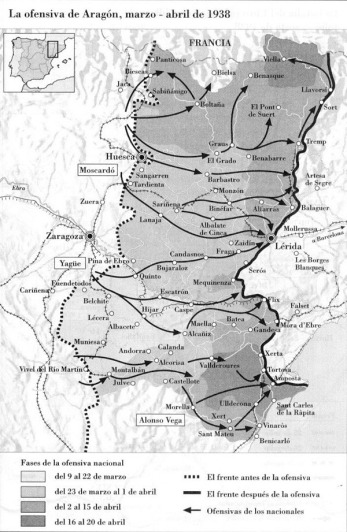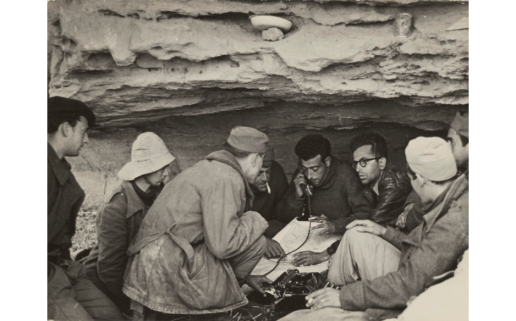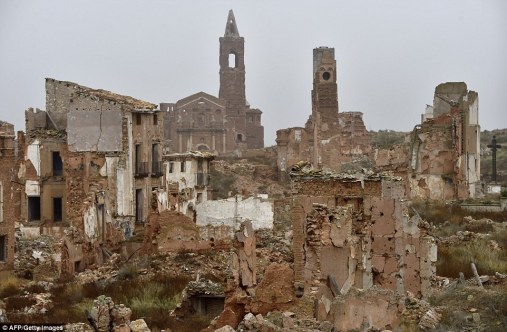March 16
With the battle of Aragon in full swing, the border with France is open to allow Russian supplies to flow down to Barcelona and into Aragon to aid the Republicans. Mussolini has a new strategy, to literally win the war with fear and terror, by bombing the civilians in Barcelona.
Barcelona has no aircraft artillery and no fighter cover. None of the Spanish Republican Air Force are based in Barcelona, leaving the city exposed to the surprise attack. At around 10pm, the Italian Aviazione Legionaria arrived from Mallorca with German Heinkel He 51s and Italian Savoia-Marchetti SM.79 and Savoia-Marchetti SM.81s to begin the first of 17 air raids, at three-hour intervals. The darkness means people are caught out by the attacks.
After weeks of fighting in Aragon, the Spanish fighters and International Brigades, led by Republican commander Vicente Rojo have established a defensive in the town of Caspe (only 130 kilometres from the eastern coast), where they have been pushed back 36 kilometres from their original front lines. The Nationalist have forced the Republicans into the centre fo Caspe, with the XV International Brigades desperate to hold the small town. The Nationalists have many troops and a strong air support behind them, and this is a last chance for the Republicans to hold back the onslaught. What begins is two days of heavy and brave fighting by the International Brigades to hold the Nationalists out of Caspe.

March 17
The Italian bombing of Barcelona continues with civilian targets hit, rather than military areas. While Barcelona has an air-raid alarm system in the city, the consistency of the attacks causes confusion, as the air-raid alarm sounds at both the beginning and end an attack. With three hourly attacks, the alarms do little more than cause panic, as the beginning and end alarms are so close together there is no telling what is happening. The bombs dropped are delayed-fuse, meaning they fall through into a building, or onto a street, then detonate, destroying things at ground level. Such a brutal and unjustified attack on civilians begins to be reported around the world, with foreign leaders condemning such cruel attacks.
The XV International Brigades and their Spanish comrades are still battling in Caspe, but are eventually overcome by the Nationalist men who are better equipped. While numbers in the battle are unknown, most of the Spanish and International men are killed in fighting, and the Nationalist battalions quickly move on to continue their march towards the coast. These battles are quickly wiping out all the men and hard work done by international volunteers through the war. The Nationalists can continue their push east and north-east, with plans to take Lleida in Catalonia, some 80 kilometres north-east.
March 18
The 17th and final bombing by the Italians hits Barcelona at 3pm. The Republican air force did not arrive until March 17, and are unable to do much to deter the heavy bombers. Overnight the working class areas of the city, where many left-wing supporters live, were badly damaged in the bombings, and the lateral force of the bombs means everything is demolished, especially innocent people. One bombs lands in the courtyard outside the Sant Felip Neri church, murdering the 30 playing refugee children who lived there. After 44 tonnes of bombs have been dropped, between 1000 and 1300 people are dead, another 2000 wounded, while the Nationalists and their Italian allies have suffered no losses. The Foreign Minister in Italy is quoted as saying “(Mussolini) was pleased by the fact that the Italians have managed to provoke horror, by their aggression instead of complacency with their mandolins. This will send up our stock in Germany, where they love total and ruthless war.” Countries around the world denounce such behaviour, yet none step in to help. As the bombing had no provocation, neither any need to stop, it is believed Barcelona has been used as a site to practice such terror raids on civilians, for later use on the nations as part of Germany’s escalation in Europe.
 remains of the Sant Felip Neri bombing
remains of the Sant Felip Neri bombing
March 20
While the fighting had been ongoing in Caspe, 27 kilometres south in Alcañiz, the Italian forces in the Nationalist camps were also gaining ground on the eastern march. Republican outposts are ill-equipped and can not fight effectively. Floods of Republican troops are fleeing through the Aragon region and also north up into Catalonia. Whole units are either collapsing in battle, or due to desertion and retreat. As the men run, both German and Italian planes were able to attack from overhead. General Karol Świerczewski, leader of International Brigades barely manages to escape the battle at Alcañiz as the Italians take over.
The Nationalists decide to pause and regroup and reorganise, as their 100,000 men are well spread out over a large region. They stop among the Ebro and Guadalope rivers, to prepare for their next attacks.
March 22
The Nationalists decided to begin a new attack, this time further 100 kilometres northwest, between Zaragoza and Huesca. This area has been part of the Republican territory since the beginning of the war, and has been part of the Aragon social revolution, where the poor and working class managed to gain control and began a new lifestyle, without government control or money, with land redistributed to help employ and feed the population. But the time has come for the area to be invaded, and the Nationalists storm the area along the 75 kilometre stretch between Zaragoza and Huesca, an east-bound flood of battle. The civilians in the area are now forced to flee or die, resulting in countless refugees leaving the Aragon region. In a single day, troops heading east from Zaragoza make it 75 kilometres to Bujaraloz and north in Huesca, they conquer 50 kilometres east towards Barbastro, with varying distances in between along the mountainous area. This strong and proud region has been cut down in only one day of battle.
March 25
Cruel General Yague is leading the Nationalist battalions out of Barastro, and manage to fight their way to Fraga, 50 kilometres east from Barbastro. This marks the day that the Nationalists finally enter the region of Catalonia, with the vast majority of Aragon now totally defeated. Republicans are either being killed, captured (death would be better), or retreat with the refugees. Fraga is only 100 kilometres from the Catalonia coast.
March 27
Yague and his men now look to push on to the larger town of Lleida, but are slowed down by a strong Republican defense, lead by Communist Valentín ‘El Campesino’ González, who is miraculously still alive throughout all these battles. Much of the Nationalist front-line has slowed due to total lack of need to fight, with most of Aragon in their possession. But El Campesino holds the northern battle area, and Colonel Duran and his men hold the southern Maestrazgo area, all fighting bravely to allow the majority of Republicans to escape into the rugged Maestrazgo mountain area in south Aragon/northern Valencia region, where they are safe and hidden. A week the Nationalists are held off as men run for safety throughout the southern Aragon region.
Another Nationalist group, fighting the 100 kilometers north from Huesca up to the Pyrenees, also encounter little resistance. The Republicans are beginning to turn on one another; Communists refuse to share artillery with anarchists, and many Republicans retreating their posts and battalions completely. Andre Marty, who is commanding the International Brigades, is seeing the total destruction of all the work done by the volunteers over the course of the war. Men are now traitors as they flee for their lives alongside their Spanish counterparts. Men are turning on eachother, with executions performed among their fellow officers if accused of being a traitor or cowards. The Republican front-lines are falling away and the International Brigades are all but lost, left to die and rot where they fall.
All is not lost; a Republican battalion manages to hold off the Nationalists at Solchaga, some 270 kilometres west of Huesca. Due to this offensive, and the battles for Lleida and Maestrazgo, precious Russian supplies are being received in Barcelona, where they can be distributed along the coast, to aid the Republicans when the Nationalists eventually arrive. The battle for the Mediterranean coast still has months to go, and the Republicans are getting armed and prepared. 
International Brigades encounter Italian troops in Gandesa, and 150 are killed, another 100 captured
March 31
The Aragon offensive is now largely over, with the exception of the far north along the Pyrenees, where Franco worries the French may rise up to defend themselves. The Nationalist men, tired and losing numbers, need to slow to recover, before finishing the region piece by piece over coming weeks. Soon the Levante offensive can begin, taking the Mediterranean coastline of the Catalonia and Valencia regions, but first the Segre river battle must be won, to take hold of water supplies and vital hydro dams which spreads from Segre to 170 kilometres north in the Pyrenees.
~~
This is not a detailed analysis, just a highlight (lowlight?) of the week’s events. Things get lost in translation – Feel free to suggest an addition/clarification/correction below. The more the world remembers, the better. All photos and captions are auto-linked to source for credit, and to provide further information.














